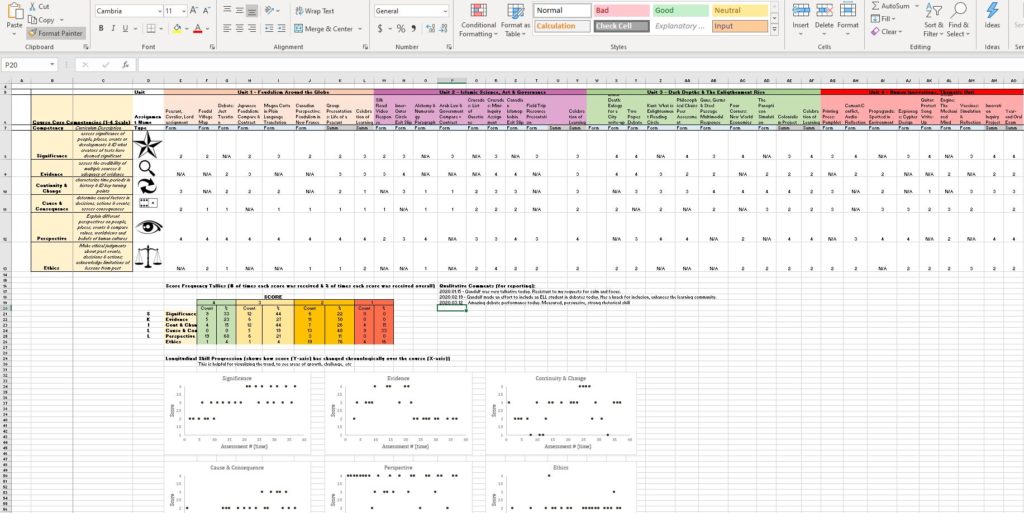In this section, I share some of my preferred teaching tools & resources. An educator is constantly seeking new programs, methods and techniques for elevating instruction. Read on to find a sampling of some of my essential digital and analogue resources:
Digital Resources
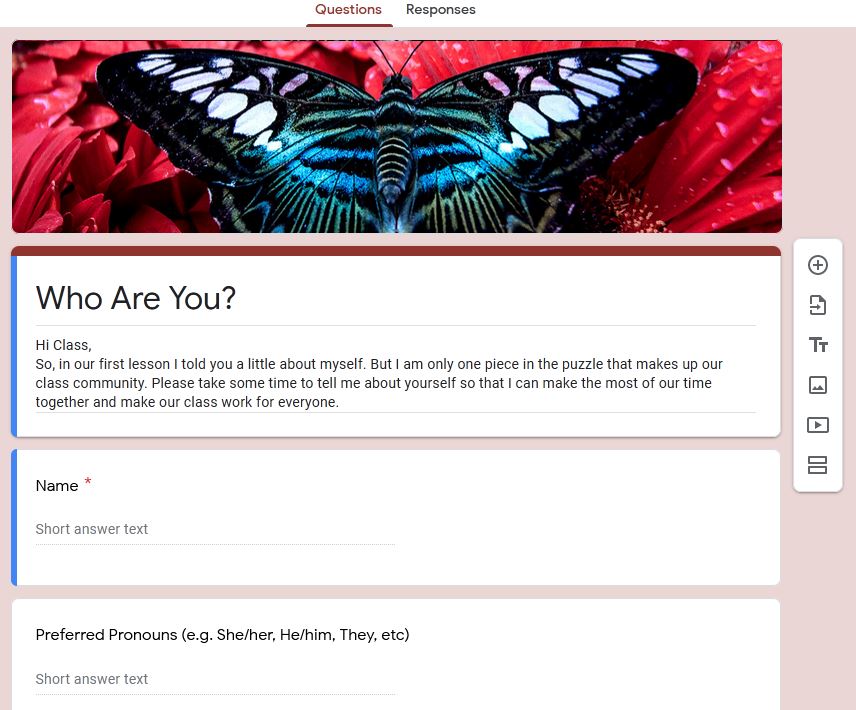 “Who Are You?” introductory survey
“Who Are You?” introductory survey
The beginning of term is a critical time for establishing a communicative and welcoming classroom environment. No learner is the same as any other, and each class cohort is a unique assemblage of perspectives, experiences and needs. One way to show that you will be the kind of teacher who values the input of students is by using a “Who Are You?” introductory survey. This gives students an opportunity to share important information with you at the outset of a course, including:
- preferred pronouns
- interests and hobbies
- technological access/resources
- learning preferences
- concerns, worries, needs
- expectations and hopes for the course
- what they expect in a teacher/a classmate/of themselves
This information is very valuable to educators. With this, you can consider the extent to which your course demands will accommodate learners. You can tweak content to match their goals, interests and concerns. Finally, you can call upon their expectations of conduct to begin the process of co-creating a social contract to ensure a respectful, productive and thriving community.
Student Digital Portfolios

Differentiation – by interest, readiness or ability – demands flexibility. If we are to create opportunities for our learners to pursue their passions while demonstrating robust evidence of learning, a uniform curriculum presents a significant barrier to this. A long-term goal of mine as an educator is to normalize the use of student-created digital portfolios in my classroom. I envision the students using the portfolios throughout a semester or year to track moments of importance, capture artifacts and reflect on their learning. I wish to interweave this process of documentation and publication into the classroom culture through the creation of a ‘documentation station’ – an area with a suite of multimedia tools such as a camera, scanner, audio recorder and computer. Using a user-friendly platform such as Weebly or Google Sites, students would design their site, explore content and form, and create a unique expression of their worldview and values. In the process, they could develop metacognition by linking their postings to specific curricular competencies or skill streams that we are developing in class. Finally, I believe that early and sustained work with a portfolio would endow learners with a multitude of transferable skills in web-design, self-publishing, rhetoric, critical thinking and visual art.
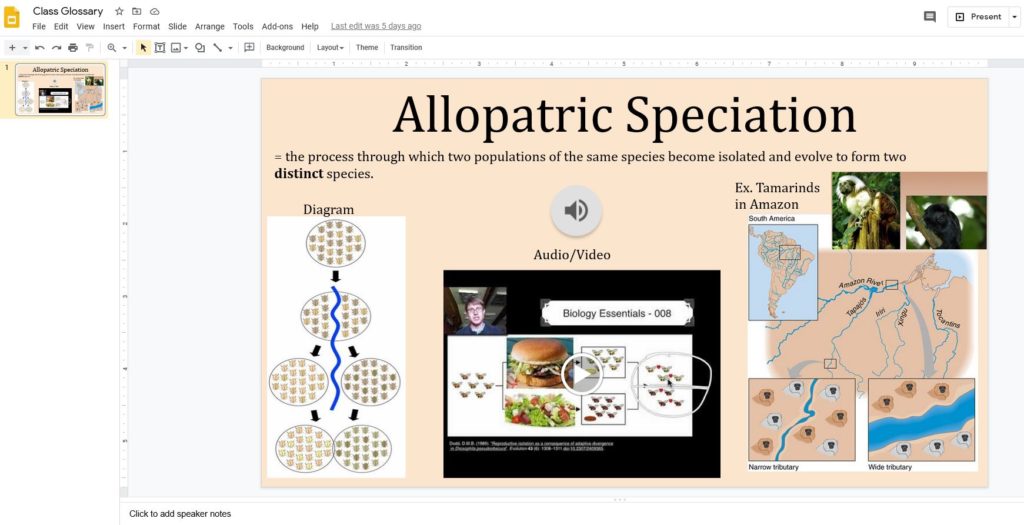 Collaborative Multimodal Glossary
Collaborative Multimodal Glossary
Cornelius Minor, author of We Got This, says that as teachers our job is to create opportunities for our students so that, in turn, they learn to create opportunities for themselves. I believe fundamentally in this ethos. I think there is a great deal of value to resources, tools and objects of inquiry that are student-generated. If this can be done at the level of the class, even better!
One ongoing, collaborative project that can function at the whole-class level is a multimodal digital glossary created on Google Slides. Each unit will contain a series of key terms. Based on their interests, students will volunteer to make entries in the collaborative glossary. Entries will be explicitly multimodal, challenging students to represent in ways that go beyond a textual definition to include audio, video, infographics, schematic diagrams, anecdotes or artifacts of other kinds. This co-created glossary provides opportunities for formative assessment (as students continuously refine their entry based on teacher feedback) and summative assessment (through inclusion of glossary terms on tests, projects and exit interviews). By giving students choice to expand their knowledge on a term that is of interest to them (e.g. allopatric speciation in Biology 11), it encourages the habit of seeking relevance. Furthermore, this tool has the potential to benefit English Language Learners in particular, by providing a centralized location for key vocabulary paired with multimodal presentations of the concept.
Smart Gradebook organized by skill streams
My gradebook is designed around my Skill Symbols system. In an effort to move my course towards competencies-based learning, I plan to organize subjects into skill streams which represent the major competencies that I wish for students to develop in the class. For instance, in this screenshot from a theoretical Socials 8 gradebook, the six core skill streams are: Significance, Evidence, Continuity & Change, Cause & Consequence, Perspective and Ethics. Each term will begin by co-defining each competency based on my goals and student input. Then, these skills – and their associated symbol/icon – will show up in assignments, exercises and assessment so that students know explicitly which competency I am investigating at a particular time. Our definitions of “proficient” demonstrations of these skills will be posted around the room for students to reference. This system is designed to be transparent, fair and to conform with the mandates of the new BC curriculum.
The gradebook is also designed to provide a longitudinal depiction of a student’s development in a particular skill over time. Using the tools inside the spreadsheet, I hope to be able to provide students with informative feedback about their development over the term. The gradebook allows room for qualitative comments to be compiled, which will be helpful in reporting habits, contributions to class culture, recommendations and commendations. Based in Excel, I will be able to look at class-wide trends and identify skills which appear to be proving most difficult for my learners. With this information, I can design remedial exercises to address these gaps and respond to the needs of my students. Finally, by separating the gradebook into skill streams, I will be able to report a specific score out of 4 for each student in each skill during conferencing and reporting. In addition to their aggregate grade, parents and students will be able to appreciate particular areas of strength and challenge.
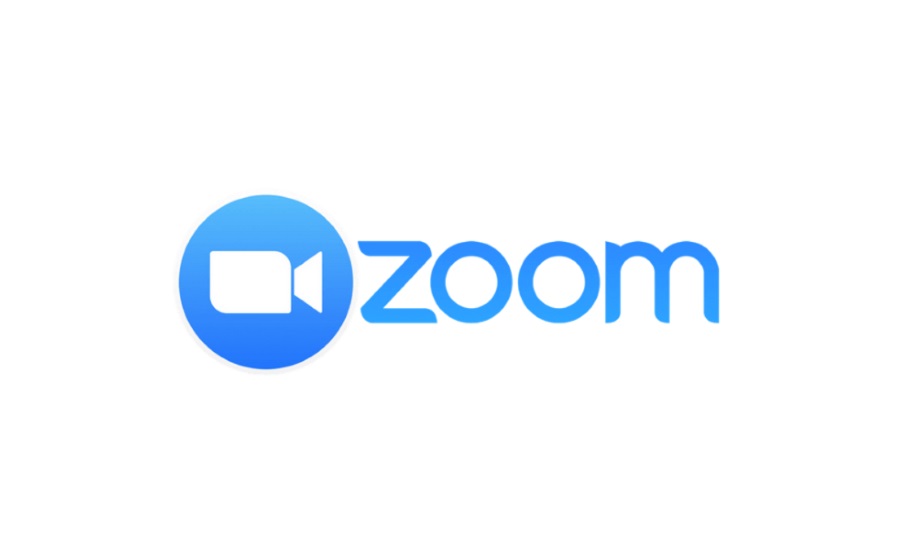 Video Conferencing via Zoom
Video Conferencing via Zoom
The nature of education is rapidly evolving to adopt new telecommunication tools such as Zoom. Videoconferencing provides two enormous opportunities for educators: facilitating remote learning models and creating new avenues for parent-teacher-student dialogue.
The recent shifts in education caused by the pandemic have created enormous demand for remote, blended and distance learning models. Zoom is a platform that is well-equipped to provide for the demands of synchronous e-Learning. The platform is lightweight, user-friendly and contains a suite of tools that can be thoughtfully employed to enhance learning. For instance, sharing your computer’s screen and audio enables the presentation of multimedia. The consistent use of breakout rooms gives students an opportunity to discuss material with peers in an environment more conducive to debate and deep conversation. Finally, Zoom can be used to easily bring in guest speakers, experts and members of the community to engage with students in real-time.
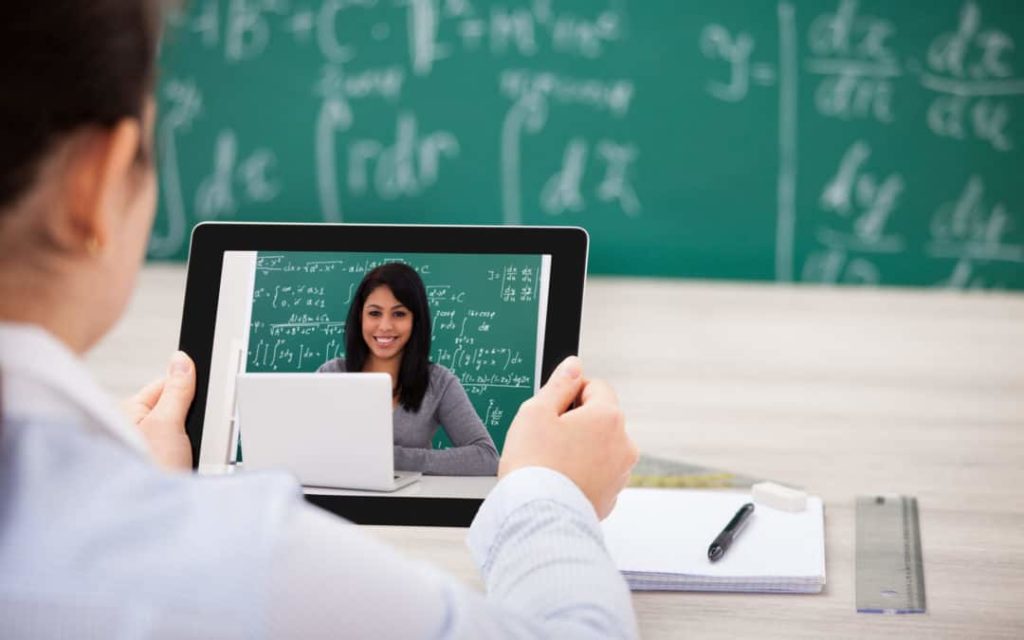 I also believe that Zoom could be leveraged in parent-teacher-student conferencing. Attendance at parent-teacher conferences appears to drop in middle- and high-school. From what I understand, there are systemic barriers that prevent interested parents from participating in conferences (e.g. travel, limited time-off, shift work). Instead of parents signing up to come to the school, those who are interested can register on an online spreadsheet and gain an opportunity to learn about their child’s experience in my class through this medium. I would encourage students to be present so that they could be included in sharing the evidence of their learning and discussing their habits and contribution to the class. With notice, I would be able to prepare some of the student’s work to be shared at the conference and gather some key info from their gradebook. I really like the idea of conferences because they are bi-directional. Unlike a report card which goes strictly from teacher → parent, a conference allows dialogue where the parent can ask for clarification, share their opinion and feel understood. I hope that by taking it online, parents would be more inclined to participate and create a relationship.
I also believe that Zoom could be leveraged in parent-teacher-student conferencing. Attendance at parent-teacher conferences appears to drop in middle- and high-school. From what I understand, there are systemic barriers that prevent interested parents from participating in conferences (e.g. travel, limited time-off, shift work). Instead of parents signing up to come to the school, those who are interested can register on an online spreadsheet and gain an opportunity to learn about their child’s experience in my class through this medium. I would encourage students to be present so that they could be included in sharing the evidence of their learning and discussing their habits and contribution to the class. With notice, I would be able to prepare some of the student’s work to be shared at the conference and gather some key info from their gradebook. I really like the idea of conferences because they are bi-directional. Unlike a report card which goes strictly from teacher → parent, a conference allows dialogue where the parent can ask for clarification, share their opinion and feel understood. I hope that by taking it online, parents would be more inclined to participate and create a relationship.
Other Resources/Tools
Indigenous Texts
The First Nations Education Steering Committee (FNESC) has expressed the importance of including authentic First Peoples texts in the classroom. These provide an opportunity for learners to engage with voices that have been historically silenced, encounter themes, knowledge and issues within Canada’s Indigenous cultures and develop an understanding of the significant contributions made by First Peoples in our province’s past and present.

My subject areas of social studies and sciences provide many opportunities to showcase and study the works of Indigenous knowledge keepers including Richard Wagamese, Thomas King, Bob Joseph, Dave Elliot Sr., Philip Kevin Paul and Robin Wall Kimmerer. I have found these works to be captivating and enriching. They have helped me to better understand the legacies of colonialism and my privilege to live, learn and create on Lekwungen & W̱SÁNEĆ territory. Indigenous texts enable us to weigh the implications of our country’s history and our responsibilities as uninvited settlers in the era of reconciliation. Furthermore, the inclusion of First Peoples voices introduces much-needed representation for the Indigenous students in our classrooms.

In-Class Simulations
A criticism that can find its way into classrooms is some variety of: “When will I possibly use this in real life?” This is a valid question and one that I believe can be addressed through the use of in-class simulations. In my teachable areas of social studies and sciences, I have begun to explore how to use simulations to teach content and skills. I’ve come to see that youth have a natural interest in developing imagined realities and occupying positions of authority. Simulations are dynamic and engaging and scaffold the development of soft skills including collaboration, communication, persuasion and active listening. Furthermore, the outcome of a well-designed simulation is emergent and not prescribed. As youth navigate the task, problems are encountered and met with novel ideas which can be debated, evaluated and implemented. The holistic, embodied experience of simulation is fundamentally aligned with the new BC curriculum’s emphasis on relevant, competencies-based learning. Because simulations can be designed such that students will mostly play it out themselves, I would be able to take notes on student performance as the simulation plays out while also recording audio/video of the activities for post-hoc analysis. Afterwards, students could write reflections to demonstrate their connection of the simulation to class concepts and themes.
So far in my career, I have had the opportunity to run several simulations and design lessons that incorporate this technique. Some examples include:
Designing a Utopia Mini-Unit – designed for use in a secondary socials class, this mini-unit invites learners to collectively design a utopian community. The class will be divided into six committees, each designated with overseeing a particular aspect of the community (e.g. home design, food production/consumption, cultural and spiritual well-being, etc.). Through this simulation, learners will consider what they value in a living space, design systems to meet their various needs and navigate the decision-making process that lies at the heart of collective living. In terms of the current COVID-19 informed educational climate, this unit could be adapted to occur online. The committee meetings, strategy sessions and presentations could all take place through Zoom. Furthermore, this unit plan may be particularly relevant at this time because of the numerous challenging social realities that students are grappling with: climate change, the pandemic, social isolation, political unrest and environmental degradation. A powerful antidote to despair may be imagining a better reality in the form of a Utopian community. (Unit Plan)
Viral Pandemic Simulation – delivered to grade 10 students at Royal Bay Secondary, this simulation involves students assuming the role of infectious disease experts to design a vaccine in response to a highly virulent global pandemic. This activity would be remarkably relevant and informative at this time. It deals with a number of concepts that are playing out in current events the globe including herd immunity, vaccine development and the need for international cooperation when faced with a global pandemic. I believe that such an activity would empower young people to better understand what is unfolding around them, and encourage them to take socially-responsible action for the benefit of the greater good. I believe it also opens the door to lots of valuable dialogue and discussion about what they are experiencing currently. Practically, with the way that cohorts are operating, there are no barriers to running the activity/simulation in terms of COVID protocols. (Activity – NB: this activity was designed by Jovian Tsang and only delivered by myself | Reflection)
The Douglas Treaties in Tableau – designed for use in a socials 10 class, this activity involves students using tableau to represent a historical event – specifically, the signing of the Douglas Treaties in BC. Students are separated into groups and receive different documentation/primary source material about the events. Students reflect on the extent to which evidence, perspective and power shape our collective memory of history. (Lesson Plan | Powerpoint)
KAIROS Blanket Exercise
A formative experience in my teacher’s education journey was taking part in the Blanket Exercise developed by KAIROS Canada. This participatory history exercise is designed to foster an experiential understanding of the impacts of 500+ years of colonialism on North America’s Indigenous peoples. As new teacher candidates, we were guided through the simulated experience of colonization spanning from pre-contact to the present. Through primary source accounts and embodied participation, we experienced a metaphor for the steady constriction of Indigenous sovereignty and intentional marginalization of Canada’s First Peoples. The activity is arresting and confronts the participants to challenge preexisting assumptions about our history. It sparks dialogue, self-reflection and shared understanding. I believe the blanket exercise is powerful and appropriate for learners across many ages and subject areas. It effectively communicates the imperative for reconciliation in an enduring way and will be delivered in my future classrooms.

Dive into Inquiry learning model
Dive Into Inquiry (DII) is an instructional guide to inquiry-based learning by a local teacher, Trevor MacKenzie from Oak Bay Secondary. My interest in project-based learning and differentiation drew me to MacKenzie’s work. MacKenzie’s practice revolves around developing and amplifying student voice through inquiry. In the book, MacKenzie takes you into his personal learning model and provides a concrete skeleton for introducing meaningful inquiry into the classroom. Some key themes that MacKenzie reinforces include:
- best practices for including learners in co-defining standards of quality and co-creating learning environments
- a reframing of the teacher from ‘sage on the stage’ to a coach, teacher, networker and facilitator
- how to use scaffolding to successfully support the migration of control from the teacher to the student
- the Four Pillars of Inquiry: jumping off points that allow the most learners to find inquiry topics that motivate them
- the importance of organizational aids during inquiry including proposals, project schedules, frequent conferencing and self-assessment tool
As an emerging educator with a strong interest in these ideas, it is extremely valuable to gain access to an organized presentation of the systems in use by a veteran teacher. DII and the materials within have helped to concretize inquiry and provide a roadmap for how I might use it to elevate learning in my own classroom.
 We Got This authentic listening strategies
We Got This authentic listening strategies
We Got This is a book I recently read that discusses best practices for practising authentic listening into classrooms. Minor is an established educational theorist who began his career working in New York City public schools. His work shines light on the issues of equity and access in our current educational system and suggests that it is our imperative to disrupt the status quo. Minor convincingly argues that racism, sexism, ableism and classism are systems of rules, policies and customs that lead to consistently unequal outcomes for specific subsets of learners. His solution lies in authentic listening through which the teacher validates their learners and becomes aware of their unmet needs.
Minor provides thoughtful and clear templates (such as “A Guide for Planning Change Quickly” and “Listening to Kids Organizer”) which teachers can use to structure deep conversations, plan interventions and assess their outcomes. As an emerging educator, I see the value in these materials. Often times, the hardest part in difficult conversations is knowing what questions to ask and Minor provides a roadmap anchored in years of experience and research. Furthermore, Minor is forthcoming with his classroom rituals and shares specific ways in which he amplifies the voice of his students and creates communicative culture. He espouses the benefits of designating student deputees, holding informal and democratic class meetings and using thoughtfully-constructed language to shift from a punitive to instructive mindset.
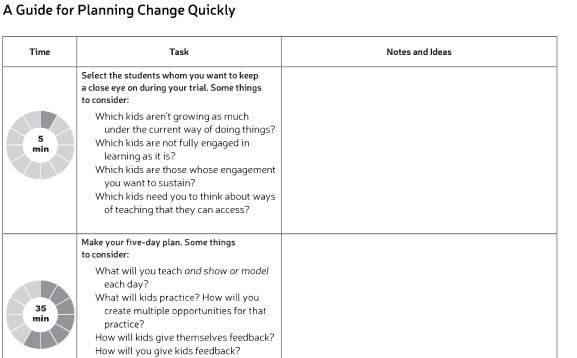
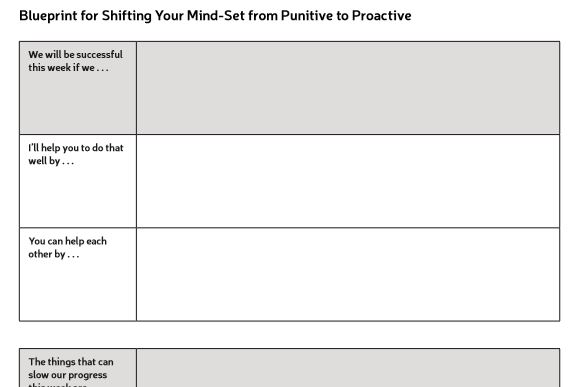
Finally, I appreciate Minor’s insistence on the importance of experimentation in the classroom. He views the classroom through the lens of an educational scientist and gives the reader permission to take initiative in their class, try interventions and collect data to monitor the outcomes. I believe this process of iteration and refinement is fundamental to a teacher’s growth mindset. Reading his work only reinforced the value of this habit for me. I have saved the accompanying templates from We Got This and fully intend to use them in my practicum and beyond.
Next: Equity Statement

